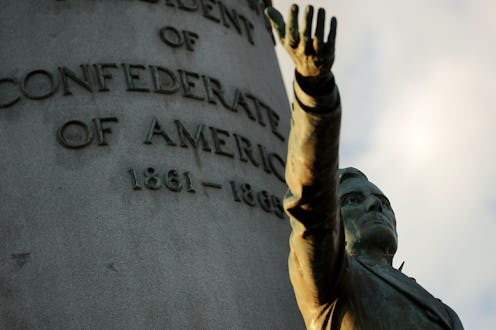News
These Stats About Confederate Memorials In The US Will Actually Stun You

The violent rally in Charlottesville in 2017 truly shook the nation to its core, what with the anti-white supremacist protestor who lost her life and the president saying afterwards that there was "blame on both sides." It's easy to forget why the alt-right gathered in Charlottesville at all, though. Initially, it was a protest over the removal of a Confederate statue. In the year since then, the number of Confederate memorials in the U.S. is rising — but not for the reason that you would expect.
According to USA Today, 75 Confederate memorials have been wiped off the map since the Charlottesville rally, either through renaming or removal. However, the Southern Poverty Law Center (SPLC), in a new report on the subject, now lists more Confederate monuments across the country than they knew about before Charlottesville. It's not that people have been putting more up as cities and their inhabitants rally to take them down; instead, the focus on Confederate monuments in 2017 merely led to more being discovered, or even just noticed, by 2018.
According to the SPLC, there are currently 1,728 Confederate monuments in the U.S., and they're not limited to just statues or explicit memorials. They also include public schools named after Confederate figures, military bases with Confederate names, and even cities or counties whose names hearken back to the Confederacy.
Alabama still celebrates Confederate president Jefferson Davis' birthday as a public holiday, the SPLC wrote, and USA Today noted that Nicholls State University in Louisiana, a public school, is named after a Confederate general who later became a governor and took away the vote from black citizens. In short, the fight to remove anything honoring the Confederacy from the American landscape has a long way to go — and USA Today noted that there are real obstacles standing in the way of that goal ever being truly fulfilled.
In addition to the fact that the political momentum has flagged since Charlottesville, it can be a difficult and expensive process. Take, for example, the public schools named after Confederate figures in Virginia. According to WSLS News, six were renamed in since Charlottesville — but there are still 13 with no plans to make that change. And according to USA Today, there's a pragmatic reason for that — it costs a lot ($170,000 for one school) to replace everything bearing the old name.
On the other hand, though, there are also myriad reasons to change those names. Despite the calls from, for example, the protestors in Charlottesville who claimed that removing the statue amounted to erasing history, NPR explained that the statues weren't put up directly after the Civil War, but rather later as a way of effectively enshrining white supremacy. According to the SPLC, they went up in two waves — first, around the turn of the century, during the period where the Jim Crow laws were being put into place. And second, in the 1950s and '60s, when the Jim Crow laws began falling during the Civil Rights movement. The Confederate history will remain, no matter how many statues and highway monuments there are. With every statue that is removed, it's only a piece of the white supremacist history that's being taken out of the public eye.